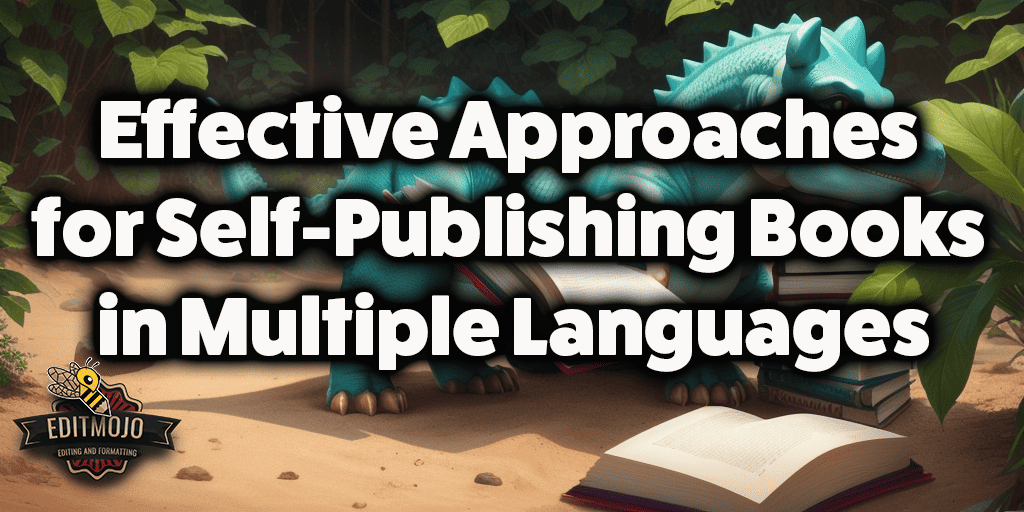Effective Approaches for Self-Publishing Books in Multiple Languages
Effective Approaches for Self-Publishing Books in Multiple Languages. In today’s digital age, the self-publishing industry is thriving, making it easier than ever for authors to share their stories with the world. One particular trend that has gained momentum is self-publishing books in multiple languages. A report by Statista underscores this, revealing a steady increase in books published in languages other than English. This self-publishing blog will delve into the self-publishing process, exploring self-publishing tips, self-publishing strategies, and effective approaches to publish your book in multiple languages.
The Promise of Multiple Language Self-Publishing
Self-publishing in multiple languages opens a world of opportunities for authorpreneurs. It significantly broadens the audience base, enhances the author’s global reputation, and increases potential book royalties. However, it also comes with a unique set of challenges like language translation, regional marketing, and distribution logistics.
Key Self-Publishing Strategies for Multiple Languages
1. Understand Your Target Audience
In the world of self-publishing, understanding your target audience is crucial. Research the reading habits, preferences, and popular genres in the regions you’re targeting. Use this information to make informed decisions about your self-publishing process.

2. Professional Translation
Professional translation is a non-negotiable aspect of self-publishing books in multiple languages. This service ensures that the story retains its essence and the author’s voice stays intact. Consider using platforms like ProZ or Gengo, which are known for their quality translations.
3. Manuscript Editing
Manuscript editing in the target language is vital. This process ensures the translated version maintains the necessary nuance and cultural sensitivity.
4. Book Cover Design
A well-designed book cover is a key self-publishing marketing tool. It’s important to adapt your book cover design to appeal to different cultural aesthetics in various regions.
5. Choose the Right Self-Publishing Platform
Among the array of self-publishing platforms, some are better suited for multi-language publishing than others. Conduct a thorough self-publishing platforms comparison to identify the best fit for your needs. Both Amazon Kindle Direct Publishing (KDP) and Smashwords support multiple languages and have extensive distribution networks.

6. Marketing and Promotion
In the realm of self-publishing, effective book marketing and promotion are essential for success. Utilize social media, author websites, and email marketing to reach your target audience. Consider hiring a PR agency that specializes in the regions you’re targeting.
Self-Publishing Resources
There are a plethora of self-publishing resources available to help you navigate the multi-language self-publishing journey. Some notable ones include:
- The Creative Penn: A blog offering self-publishing advice and resources.
- Reedsy: An online platform offering services like editing, cover design, and marketing.
- The Alliance of Independent Authors: A professional association for self-publishing authors.
- Editmojo: Perfect for authors looking for editing and formatting services as well as help self-publishing.
Conclusion
The journey of self-publishing books in multiple languages may seem daunting, but the potential rewards make it worth the effort. By leveraging professional translation services, understanding your target audience, choosing the right self-publishing platform, and investing in manuscript editing and book cover design, you can successfully navigate this process.
Self-Publishing Success Stories
There are many self-publishing success stories that offer inspiration. One such author is Joanna Penn, a successful authorpreneur who has successfully self-published her books in multiple languages. These examples underscore the potential that multi-language self-publishing holds for authors worldwide.

Self-Publishing vs. Traditional Publishing
It’s important to weigh the self-publishing advantages and disadvantages against traditional publishing. Self-publishing offers control over the creative process, potential for higher royalties, and the freedom to market your book. However, it also involves more upfront costs and requires a significant time investment. On the other hand, traditional publishing provides professional editing, design, and marketing services but offers lower royalties and less creative control. The choice depends on your personal preference and career goals.
The Future of Self-Publishing
As we look forward to the self-publishing trends 2023, we anticipate an increase in multi-language self-publishing, driven by advancements in translation technology and the continued growth of the global reading market. The self-publishing industry is becoming increasingly accessible, offering new avenues for authors to reach readers worldwide.
Final Thoughts
The world of self-publishing is vast and ever-changing. As an authorpreneur, adapting and leveraging these changes can lead to significant success. Remember, in this journey, it’s essential to keep learning, stay updated with the latest self-publishing trends, and continuously refine your self-publishing strategies.
Happy self-publishing!
If you found this guide helpful, consider exploring more self-publishing tips and tricks on our blog. Sign up for our newsletter to receive the latest updates and resources in the self-publishing industry.
